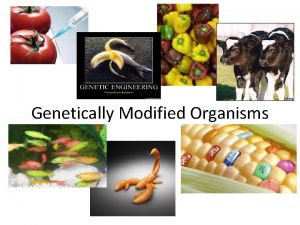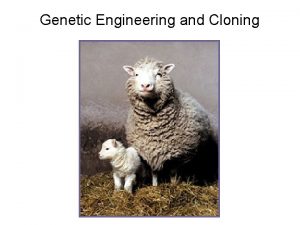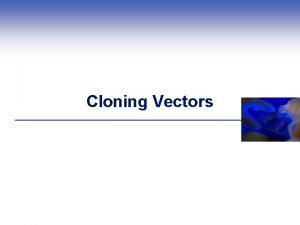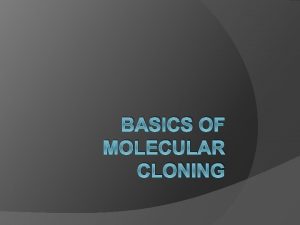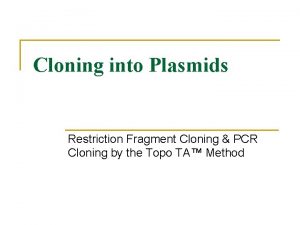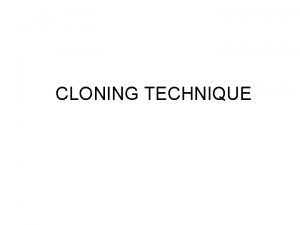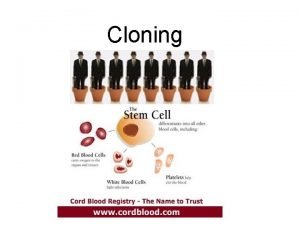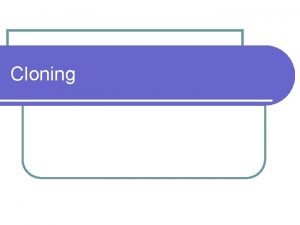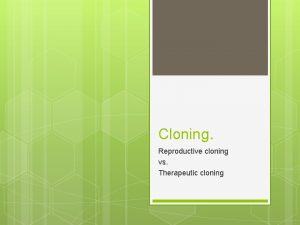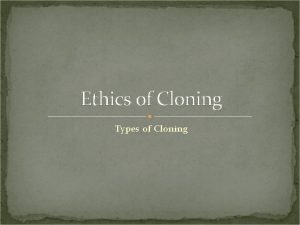Human Cloning Cloning produces cells that are genetically















- Slides: 15

Human Cloning

Cloning produces cells that are genetically similar to each other (have the same DNA).

Types of Cloning �There are two types of cloning: 1) Therapeutic cloning is the use of (stem) cells for medicinal or research purposes. 2) Reproductive cloning would be using (somatic) cells to create cloned humans.

Therapeutic Cloning Nucleus of an egg cell is replaced with the nucleus of a body cell. 2. Egg cell is stimulated with electricity. 3. Embryo grows. 4. Embryo stem cells are collected and used to treat the donor. 1.


Problems with Therapeutic Cloning �Therapeutic cloning creates embryos and then destroys them for stem cells, which is morally wrong to some.

Reproductive cloning uses the cloning procedure to produce a clonal embryo which is implanted in a woman's womb with intent to create a fully formed living child--a clone.

Reproductive Cloning Nucleus of an egg cell is replaced with the nucleus of a body cell. 2. Egg cell is stimulated with electricity. 3. Embryo is put into a uterus and allowed to grow and be born. 4. The baby is an exact genetic copy of the donor! 1.

Reproductive Cloning Technology used to generate an animal that has the same DNA as another currently or previously existing animal. Dolly the sheep was created by reproductive cloning technology. First dog clone (Afghan Hound)

How does it work? Scientists use “somatic cell nuclear transfer” (SCNT). Transfer genetic material from the nucleus of a donor adult cell to an egg whose nucleus (so its genetic material) has been removed. Reconstructed egg containing the transferred DNA is treated with chemicals or electric current to stimulate cell division. Once the cloned embryo reaches a suitable stage, it is transferred to the uterus of a female host where it continues to develop until birth.


Early Successes – Human Cloning 2001 – First cloned human embryos (only to six cell stage) created by Advanced Cell Technology (USA) 2004 – Claim of first human cloned blastocyst created and a cell line established (Korea) – later proved to be fraudulent

Principle of Human cloning

Problems with Reproductive Cloning Reproductive cloning is deemed morally wrong because it is creating a human life just to be a walking organ donor for the person after whom they were created.

What are the risks of cloning? 1. Reproductive cloning is expensive and highly inefficient 2. Cloned animals tend to have more compromised immune function and higher rates of infection, tumor growth, and other disorders. 3. The Defects in the genetic imprint of DNA from a single donor cell may lead to some of the developmental abnormalities of cloned embryos.
 Antigentest åre
Antigentest åre Identify the structure
Identify the structure Clonaid
Clonaid Produces diploid cells
Produces diploid cells Where semen stored
Where semen stored A spermatocyte produces the following four sperm cells
A spermatocyte produces the following four sperm cells Phân độ lown ngoại tâm thu
Phân độ lown ngoại tâm thu Block nhĩ thất độ 2 mobitz 1
Block nhĩ thất độ 2 mobitz 1 Thơ thất ngôn tứ tuyệt đường luật
Thơ thất ngôn tứ tuyệt đường luật Thơ thất ngôn tứ tuyệt đường luật
Thơ thất ngôn tứ tuyệt đường luật Chiến lược kinh doanh quốc tế của walmart
Chiến lược kinh doanh quốc tế của walmart Tìm vết của đường thẳng
Tìm vết của đường thẳng Hãy nói thật ít để làm được nhiều
Hãy nói thật ít để làm được nhiều Tôn thất thuyết là ai
Tôn thất thuyết là ai Gây tê cơ vuông thắt lưng
Gây tê cơ vuông thắt lưng Sau thất bại ở hồ điển triệt
Sau thất bại ở hồ điển triệt
















